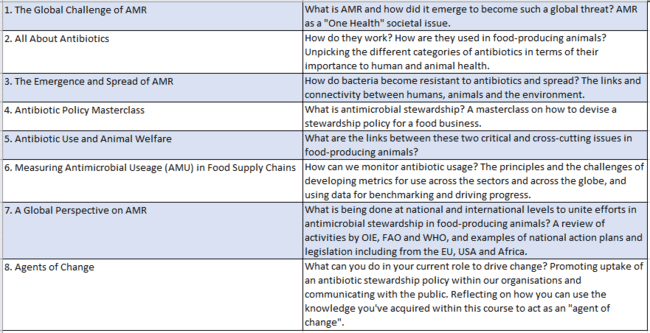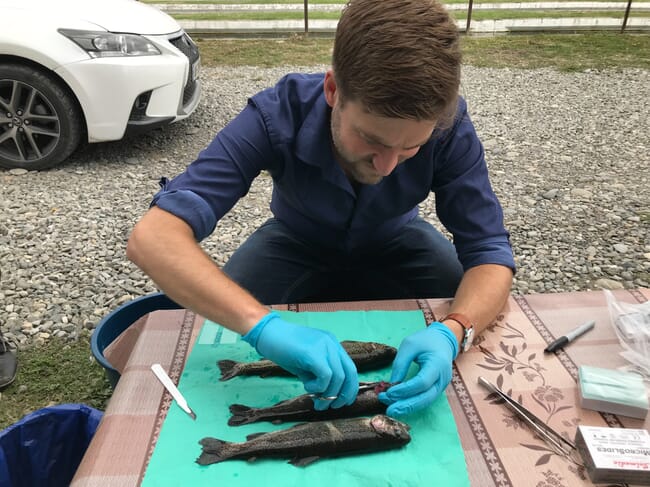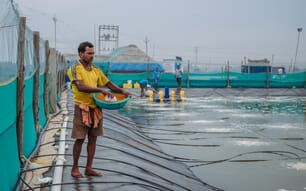The interactive course has been produced by food security consultancy FAI Farms and endorsed by Responsible Use of Medicines in Agriculture Alliance (RUMA). It is being billed as an essential tool for educating professionals working in the global food industry on how to mitigate the risks of emerging antimicrobial resistance (AMR).

FAI's Laura Higham spoke to The Fish Site about the reasons behind developing the course and why antimicrobial stewardship is so essential to the future of food and farming, as well as to both human and animal health. We also spoke to Chris Matthews, operations director at Fish Vet Group, who added some thoughts on why the topic is relevant to aquaculture professionals.
What prompted FAI to design this course?
LH: FAI has been working for 20 years to drive sustainability in commercial food animal supply chains. In recent years we have supported numerous food businesses in antimicrobial stewardship policy and data collection. There is a lack of governance, standards and frameworks for policy and data reporting for antibiotic usage in food chains. Because of this, FAI decided to bring together the science and our experience to create a very practical course that equips food industry professionals with the knowledge, skills and tools they need to tackle this pressing issue.
Why is antimicrobial stewardship such a compelling issue?
LH: Antimicrobial resistance (AMR) is amongst the most significant and pressing health challenges facing human civilisation. It is responsible for an estimated 700,000 human deaths per year and is expected to rise to 10 million human deaths per year by 2050. The cumulative cost to global economic output is estimated at US $100 trillion. This is due to the declining effectiveness of antibiotic drugs in treating serious infections in people, causing prolonged hospital stays and increasing rates of illness and death. We know that the use of antibiotics in livestock contributes to the global burden of AMR and those of us working in the food industry hold great influence for driving positive impact and reducing public health risks.
How is the course structured?
LH: The course is delivered over eight modules (see text box), with each module taking participants one hour with extra time for assignments. It is purely an online course, meaning it can be worked through at your own pace, around busy work and home lives.

How much of an issue is AMR in aquaculture globally?
CM: The range of aquaculture species and environments in which we farm them is much more diverse than on land, and the situation across the breadth of these not easily summarised. We see the most AMR where antibiotic use is high, and in too many aquaculture sectors globally antibiotics are overused – most severely in developing countries where their availability is often unregulated. I’ve seen this myself working in fish farms in such developing countries, where without access to diagnostics or advice on correct administration, farmers attempt to treat undiagnosed diseases - some of which may not be bacterial in nature - with antibiotics purchased without the involvement of a vet or other qualified adviser.
By contrast, veterinary colleagues working with terrestrial species are often surprised to learn that Atlantic salmon in Scotland and Norway receive the lowest levels of antibiotic in terms of milligrams per kilogram farmed weight of all major meat producing species in those countries. The vast majority of salmon farmed in these countries will not receive antibiotics at any stage in their cycle. This has been achieved through the development of successful vaccines for the major bacterial pathogens and, critically, an improved focus on husbandry and hygiene. This is a fragile success which should not be taken for granted.
What, in your opinion, is the biggest challenge associated with antimicrobial stewardship?
LH: Antibiotic use is a key driver of antimicrobial resistance, and therefore our behaviour in utilising these important medicines is critical in determining future health outcomes associated with bacterial infections. If we use antibiotics with great care – employing principles of antimicrobial stewardship utilising alternatives where possible, and – fundamentally - ensuring we have the best possible systems of management and husbandry to support the health and welfare of food animal species, we may be able to retain them as vital tools in the toolbox of modern medicine. If their use continues to rise unabated, propping up poor management systems and with overuse and misuse dominating in some settings, we may see a reversal in medical progress resulting in human and animal suffering. Human behaviour is very difficult to change, especially on such a large scale, but food businesses are in a remarkable position to drive improvement in antibiotic usage in billions of food animals, accounting for a considerable proportion of consumption at global level.
What aspects of AMR stewardship does the course cover?
LH: The course has eight modules and teaches participants how antibiotics work and how they are categorised. It also covers how resistant bacteria emerge and spread, how to measure medicine usage in food-producing species and how we can all act as an agent of change. It also provides an antimicrobial stewardship masterclass, which guides participants through the development of a gold standard policy for their business, step-by-step (see text box).
Who is the course for?
LH: The course is aimed at professionals from retail companies, food service businesses, suppliers, processors and farming businesses. This course is uniquely positioned to support these professional individuals and teams, acknowledging that they are critical decision makers in the development of standards and policy, including around antibiotic use in animals. The course complements existing on-farm and veterinary training.
What should participants take away from the content?
LH: Participants should enjoy the varied and interactive course features, including tasks, videos, quizzes and assignments, as well as the flexibility it offers to fit study around busy work and home lives. The course includes expert contributions from international leaders in the field – from academia, research, industry and policy backgrounds. Participants should take away a deep understanding of the “One Health” issue of AMR, and new knowledge, skills and inspiration to tackle the problem in a meaningful way in their professional roles.
What feedback have you received from industry partners?
LH: RUMA has reviewed and endorsed the course, stating: “These are excellent resources that will help to elevate the level of understanding and appreciation of this complex topic within the food supply chain globally. The end result should be that food businesses are able to develop sensible, effective policies on antibiotic stewardship that never compromise animal health and welfare or food safety.” We are delighted that RUMA support this course – and it should complement their ongoing work in the industry, for example their very successful Targets Task Force.
What impact do you hope the course will have?
LH: We believe that empowering food business professionals with the skills and knowledge to tackle the complex One Health issue of AMR will be one of the most important steps in controlling antibiotic use in animals – making a real impact in terms of reducing the risk of antimicrobial resistance in our communities.

© Fish Vet Group
How can we prevent AMR in aquaculture?
CM: The short answer is that all of us involved in aquaculture should be striving in practice to eliminate the use of antibiotics. Of course, salmonid aquaculture in Europe is quite different to tilapia farming in North Africa and the scale of that challenge will differ around the world.
Availability of veterinary antimicrobials for fish is an issue. I have read NGO reports for developing countries citing unavailability of veterinary medicines as a major barrier to sustainable growth, only to visit and find antibiotics very freely available outside of any veterinary involvement. Governments need to regulate the supply of antibiotics, but also encourage fast access to diagnostic labs, training and advice on preventative health for their aquaculture sectors. The goal of eliminating antibiotic use in aquaculture entirely may be unrealistic, but in very many countries I believe substantial reductions could be made quickly which would dwarf the incremental improvements we are looking for in the best performing sectors.
Vaccines can be central to preventing bacterial disease, though even the best vaccines can be overwhelmed if there is not attention to all other aspects of disease prevention. Where vaccines are available, farmers have a role to play in pharmacovigilance by reporting instances of disease in vaccinated fish to their vet and the vaccine manufacturers in turn, who are then better able to keep the antigen profile updated against emergent variants of a given bacterial disease.
One interesting emergent approach is the use of bacteriophages – viruses which are naturally occurring pathogens of bacteria. Some of these can be isolated, grown and used to treat bacterial diseases. This work was initially pioneered in the former Soviet Union but was side-lined by the increasing availability of antibiotics following the Second World War. Due to AMR, there is renewed interest in bacteriophages and their application in human and animal health. The recent launch of a bacteriophage product to treat Yersiniosis in salmon in Norway is a major milestone and I look forward to seeing more phage products emerge for aquaculture in the future.
To find out more about the FAI course click here and watch the launch video here.


